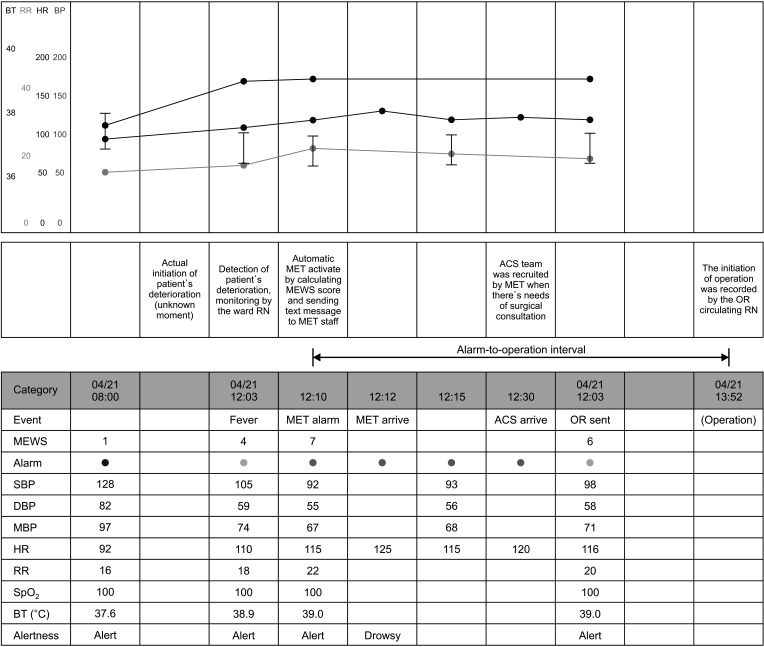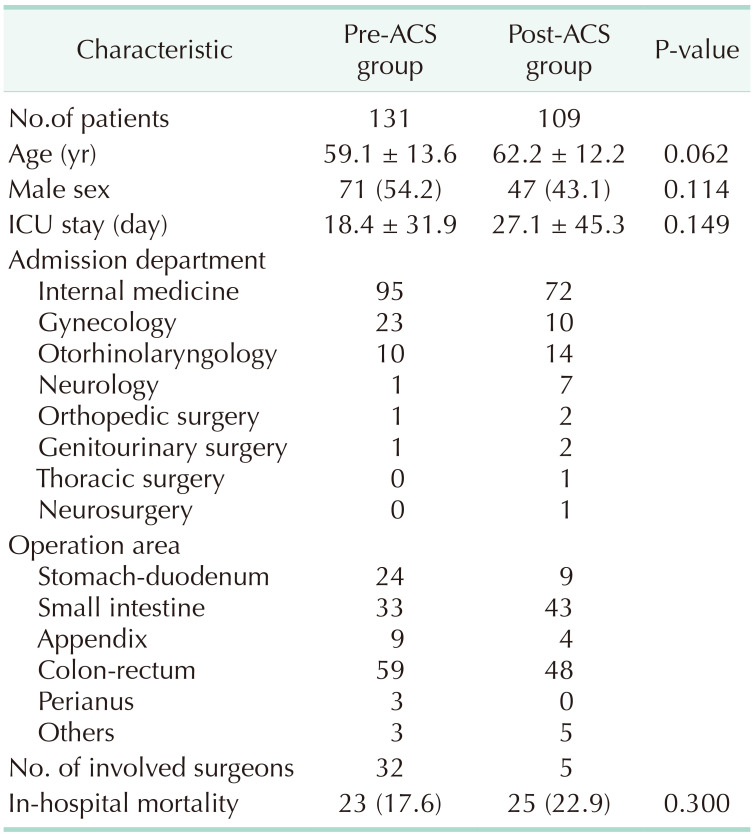1. Jones DA, DeVita MA, Bellomo R. Rapid-response teams. N Engl J Med. 2011; 365:139–146. PMID:
21751906.
2. Devita MA, Bellomo R, Hillman K, Kellum J, Rotondi A, Teres D, et al. Findings of the first consensus conference on medical emergency teams. Crit Care Med. 2006; 34:2463–2478. PMID:
16878033.
3. Chana P, Burns EM, Arora S, Darzi AW, Faiz OD. A systematic review of the impact of dedicated emergency surgical services on patient outcomes. Ann Surg. 2016; 263:20–27. PMID:
26840649.
4. Tran A, Fernando SM, McIsaac DI, Rochwerg B, Mok G, Seely AJ, et al. Predictors of mortality and cost among surgical patients requiring rapid response team activation. Can J Surg. 2020; 63:E598–E605. PMID:
33295715.
5. Choi MS, Lee DS, Park CM. Evaluation of medical emergency team activation in surgical wards. J Acute Care Surg. 2019; 9:54–59.
6. Committee to Develop the Reorganized Specialty of Trauma, Surgical Critical Care, and Emergency Surgery. Acute care surgery: trauma, critical care, and emergency surgery. J Trauma. 2005; 58:614–616. PMID:
15761359.
7. Kim TH, Park JY, Jung YT, Lee SH, Jung MJ, Lee JG. 10 Years of acute care surgery: experiences in a single tertiary university hospital in Korea. J Acute Care Surg. 2020; 10:96–100.
8. Park CI, Kim JH, Park SJ, Kim SH, Kim HH, Hong SK, et al. Acute care surgery: implementation in Korea. J Acute Care Surg. 2018; 8:51–58.
9. Barnes SL, Cooper CJ, Coughenour JP, MacIntyre AD, Kessel JW. Impact of acute care surgery to departmental productivity. J Trauma. 2011; 71:1027–1034. PMID:
21986743.
10. Kutcher ME, Sperry JL, Rosengart MR, Mohan D, Hoffman MK, Neal MD, et al. Surgical rescue: the next pillar of acute care surgery. J Trauma Acute Care Surg. 2017; 82:280–286. PMID:
27893639.
11. Briggs A, Peitzman AB. Surgical rescue in medical patients: the role of acute care surgeons as the surgical rapid response team. Crit Care Clin. 2018; 34:209–219. PMID:
29482901.
12. Gardner-Thorpe J, Love N, Wrightson J, Walsh S, Keeling N. The value of Modified Early Warning Score (MEWS) in surgical in-patients: a prospective observational study. Ann R Coll Surg Engl. 2006; 88:571–575. PMID:
17059720.
13. Lim SY, Park SY, Park HK, Kim M, Park HY, Lee B, et al. Early impact of medical emergency team implementation in a country with limited medical resources: a before-and-after study. J Crit Care. 2011; 26:373–378. PMID:
21036527.
14. Na SJ, Ko RE, Ko MG, Koh A, Chung CR, Suh GY, et al. Risk factors for early medical emergency team reactivation in hospitalized patients. Crit Care Med. 2020; 48:e1029–e1037. PMID:
32941188.
15. Moreno RP, Metnitz PG, Almeida E, Jordan B, Bauer P, Campos RA, et al. SAPS 3: from evaluation of the patient to evaluation of the intensive care unit. Part 2: development of a prognostic model for hospital mortality at ICU admission. Intensive Care Med. 2005; 31:1345–1355. PMID:
16132892.
16. Ferreira FL, Bota DP, Bross A, Mélot C, Vincent JL. Serial evaluation of the SOFA score to predict outcome in critically ill patients. JAMA. 2001; 286:1754–1758. PMID:
11594901.
17. Maharaj R, Raffaele I, Wendon J. Rapid response systems: a systematic review and meta-analysis. Crit Care. 2015; 19:254. PMID:
26070457.
18. Lee DS, Suh GY, Ryu JA, Chung CR, Yang JH, Park CM, et al. Effect of early intervention on long-term outcomes of critically ill cancer patients admitted to ICUs. Crit Care Med. 2015; 43:1439–1448. PMID:
25803653.
19. Yang E, Lee H, Lee SM, Kim S, Ryu HG, Lee HJ, et al. Effectiveness of a daytime rapid response system in hospitalized surgical ward patients. Acute Crit Care. 2020; 35:77–86. PMID:
32506872.
20. Lee YJ, Lee DS, Min H, Choi YY, Lee EY, Song I, et al. Differences in the clinical characteristics of rapid response system activation in patients admitted to medical or surgical services. J Korean Med Sci. 2017; 32:688–694. PMID:
28244298.
21. Ross SW, Reinke CE, Ingraham AM, Holena DN, Havens JM, Hemmila MR, et al. Emergency general surgery quality improvement: a review of recommended structure and key issues. J Am Coll Surg. 2022; 234:214–225. PMID:
35213443.
22. Aggarwal G, Peden CJ, Mohammed MA, Pullyblank A, Williams B, Stephens T, et al. Evaluation of the collaborative use of an evidence-based care bundle in emergency laparotomy. JAMA Surg. 2019; 154:e190145. PMID:
30892581.
23. Ciarleglio FA, Rigoni M, Mereu L, Tommaso C, Carrara A, Malossini G, et al. The negative effects of COVID-19 and national lockdown on emergency surgery morbidity due to delayed access. World J Emerg Surg. 2021; 16:37. PMID:
34256781.
24. Gajic O, Urrutia LE, Sewani H, Schroeder DR, Cullinane DC, Peters SG. Acute abdomen in the medical intensive care unit. Crit Care Med. 2002; 30:1187–1190. PMID:
12072666.
25. Patel SV, Groome PA, J Merchant S, Lajkosz K, Nanji S, Brogly SB. Timing of surgery and the risk of complications in patients with acute appendicitis: a population-level case-crossover study. J Trauma Acute Care Surg. 2018; 85:341–347. PMID:
29787550.





 PDF
PDF Citation
Citation Print
Print







 XML Download
XML Download